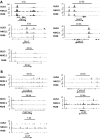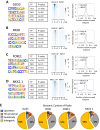GLIS3 regulates transcription of thyroid hormone biosynthetic genes in coordination with other thyroid transcription factors
- PMID: 36793061
- PMCID: PMC9930322
- DOI: 10.1186/s13578-023-00979-8
GLIS3 regulates transcription of thyroid hormone biosynthetic genes in coordination with other thyroid transcription factors
Abstract
Background: Loss of the transcription factor GLI-Similar 3 (GLIS3) function causes congenital hypothyroidism (CH) in both humans and mice due to decreased expression of several thyroid hormone (TH) biosynthetic genes in thyroid follicular cells. Whether and to what extent, GLIS3 regulates thyroid gene transcription in coordination with other thyroid transcriptional factors (TFs), such as PAX8, NKX2.1 and FOXE1, is poorly understood.
Methods: PAX8, NKX2.1, and FOXE1 ChIP-Seq analysis with mouse thyroid glands and rat thyrocyte PCCl3 cells was performed and compared to that of GLIS3 to analyze the co-regulation of gene transcription in thyroid follicular cells by these TFs.
Results: Analysis of the PAX8, NKX2.1, and FOXE1 cistromes identified extensive overlaps between these TF binding loci and those of GLIS3 indicating that GLIS3 shares many of the same regulatory regions with PAX8, NKX2.1, and FOXE1, particularly in genes associated with TH biosynthesis, induced by thyroid stimulating hormone (TSH), and suppressed in Glis3KO thyroid glands, including Slc5a5 (Nis), Slc26a4, Cdh16, and Adm2. ChIP-QPCR analysis showed that loss of GLIS3 did not significantly affect PAX8 or NKX2.1 binding and did not cause major alterations in H3K4me3 and H3K27me3 epigenetic signals.
Conclusions: Our study indicates that GLIS3 regulates transcription of TH biosynthetic and TSH-inducible genes in thyroid follicular cells in coordination with PAX8, NKX2.1, and FOXE1 by binding within the same regulatory hub. GLIS3 does not cause major changes in chromatin structure at these common regulatory regions. GLIS3 may induce transcriptional activation by enhancing the interaction of these regulatory regions with other enhancers and/or RNA Polymerase II (Pol II) complexes.
Keywords: FOXE1; GLIS3; Gene transcription; NIS; NKX2.1; PAX8; PCCl3; TSH; Thyroid follicular cells; Thyroid hormone biosynthesis.
© 2023. This is a U.S. Government work and not under copyright protection in the US; foreign copyright protection may apply.
Conflict of interest statement
The authors declare that they have on competing interests.
Figures







Similar articles
-
GLIS3 expression in the thyroid gland in relation to TSH signaling and regulation of gene expression.Cell Mol Life Sci. 2024 Jan 28;81(1):65. doi: 10.1007/s00018-024-05113-6. Cell Mol Life Sci. 2024. PMID: 38281222 Free PMC article.
-
Role of GLIS3 in thyroid development and in the regulation of gene expression in thyroid specific Glis3KO mice.Res Sq [Preprint]. 2023 Jul 7:rs.3.rs-3044388. doi: 10.21203/rs.3.rs-3044388/v1. Res Sq. 2023. Update in: Cell Mol Life Sci. 2024 Jan 28;81(1):65. doi: 10.1007/s00018-024-05113-6. PMID: 37461635 Free PMC article. Updated. Preprint.
-
Regulation of Foxe1 by Thyrotropin and Transforming Growth Factor Beta Depends on the Interplay Between Thyroid-Specific, CREB and SMAD Transcription Factors.Thyroid. 2019 May;29(5):714-725. doi: 10.1089/thy.2018.0136. Epub 2019 Feb 13. Thyroid. 2019. PMID: 30652527
-
The role of GLIS3 in thyroid disease as part of a multisystem disorder.Best Pract Res Clin Endocrinol Metab. 2017 Mar;31(2):175-182. doi: 10.1016/j.beem.2017.04.007. Epub 2017 Apr 21. Best Pract Res Clin Endocrinol Metab. 2017. PMID: 28648506 Review.
-
Transcription factor GLIS3: Critical roles in thyroid hormone biosynthesis, hypothyroidism, pancreatic beta cells and diabetes.Pharmacol Ther. 2020 Nov;215:107632. doi: 10.1016/j.pharmthera.2020.107632. Epub 2020 Jul 18. Pharmacol Ther. 2020. PMID: 32693112 Free PMC article. Review.
Cited by
-
GLIS3: A novel transcriptional regulator of mitochondrial functions and metabolic reprogramming in postnatal kidney and polycystic kidney disease.Mol Metab. 2024 Dec;90:102052. doi: 10.1016/j.molmet.2024.102052. Epub 2024 Nov 5. Mol Metab. 2024. PMID: 39505148 Free PMC article.
-
GLIS3 expression in the thyroid gland in relation to TSH signaling and regulation of gene expression.Cell Mol Life Sci. 2024 Jan 28;81(1):65. doi: 10.1007/s00018-024-05113-6. Cell Mol Life Sci. 2024. PMID: 38281222 Free PMC article.
-
The Influence of Micronutrients and Environmental Factors on Thyroid DNA Integrity.Nutrients. 2025 Jun 21;17(13):2065. doi: 10.3390/nu17132065. Nutrients. 2025. PMID: 40647171 Free PMC article. Review.
-
Circulating pancreatic enzyme levels are a causal biomarker of type 1 diabetes.medRxiv [Preprint]. 2024 Aug 9:2024.08.08.24311619. doi: 10.1101/2024.08.08.24311619. medRxiv. 2024. PMID: 39148858 Free PMC article. Preprint.
References
-
- Lopez-Marquez A, Carrasco-Lopez C, Fernandez-Mendez C, Santisteban P. Unraveling the complex interplay between transcription factors and signaling molecules in thyroid differentiation and function, from embryos to adults. Front Endocrinol. 2021;12:654569. doi: 10.3389/fendo.2021.654569. - DOI - PMC - PubMed
Grants and funding
LinkOut - more resources
Full Text Sources
Molecular Biology Databases
Miscellaneous

